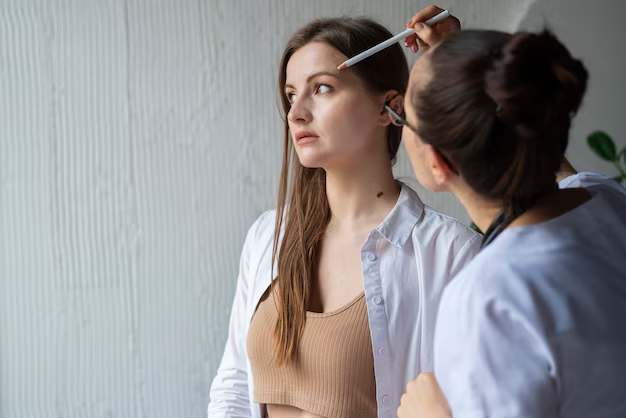Understanding Rosacea: Recognize the Signs and Take Control
Have you ever looked in the mirror and noticed persistent redness on your cheeks, nose, or forehead? Perhaps you've experienced sudden flare-ups of flushing, visible blood vessels, or even small, pus-filled bumps. If these symptoms sound familiar, you might be wondering, "Could this be rosacea?" Let's explore the signs, symptoms, and steps you can take to better understand this common skin condition.
What Is Rosacea?
Rosacea is a chronic skin disorder primarily affecting the face. It's more common than you might think, affecting millions of people worldwide. Characterized by cycles of flare-ups and remissions, it often begins with a tendency to blush easily. Over time, persistent redness can develop, along with other symptoms.
Rosacea can be bothersome, impacting self-esteem and confidence. However, with the right knowledge and management strategies, you can keep it under control.
Common Symptoms of Rosacea
While rosacea manifests differently in each individual, several common symptoms may help you identify the condition:
- Persistent Redness: Resembling a sunburn that won't fade, this is often the first and most noticeable sign.
- Flushing: Episodes of flushing, where the skin turns red rapidly, can last for several minutes.
- Visible Blood Vessels: Small blood vessels become more noticeable on the skin's surface.
- Bumps and Pimples: These may resemble acne but aren't caused by the same factors.
- Thickened Skin: Over time, the skin, especially around the nose, can thicken.
- Eye Irritations: Some people experience dryness or irritation of the eyes, a condition known as ocular rosacea.
Is It Rosacea? Identifying the Signs
Determining if you have rosacea can be challenging, as symptoms vary. However, certain patterns can give you clues. Consider the following questions to help gauge your condition:
- Do you frequently experience facial redness or flushing?
- Have small blood vessels become more visible on your skin?
- Do you notice acne-like pimples or bumps on your face?
- Is your skin sensitive or easily irritated by certain products or weather conditions?
If you answered "yes" to these questions, you may want to delve deeper into understanding rosacea. However, it's essential not to jump to conclusions. Consulting a healthcare professional for an accurate diagnosis is always recommended.
Diving Deeper: Types of Rosacea
Rosacea presents itself in various forms, each with unique characteristics. Understanding these can help you identify your symptoms more precisely. Here are the four primary subtypes of rosacea:
1. Erythematotelangiectatic Rosacea (ETR)
- Characteristics: Predominant redness and visible blood vessels; frequent flushing.
- Common Triggers: Sun exposure, stress, spicy foods, and temperature extremes.
2. Papulopustular Rosacea
- Characteristics: Acne-like breakouts, redness, and skin swelling.
- Common Triggers: Certain medications, alcohol, and high levels of physical activity.
3. Phymatous Rosacea
- Characteristics: Thickened skin with a bumpy texture, often affecting the nose.
- Common Triggers: Untreated rosacea over time, potentially influenced by genetic factors.
4. Ocular Rosacea
- Characteristics: Irritation, redness, and swelling of the eyes and eyelids.
- Common Triggers: Eye strain, makeup, and certain skincare products.
Managing Rosacea: Practical Tips for Daily Life
While there's no cure for rosacea, several strategies can help manage symptoms and prevent flare-ups. Here's how you can take control of your condition:
Skincare Tips for Rosacea
- Choose Gentle Products: Opt for fragrance-free, hypoallergenic skincare items to prevent irritation.
- Sun Protection is Key: Apply sunscreen daily, even on cloudy days, to protect sensitive skin.
- Moisturize Regularly: Keeping your skin hydrated can reduce dryness and irritation.
- Avoid Abrasive Exfoliants: Gentle cleansing is crucial to avoid exacerbating redness and peeling.
Lifestyle Adjustments
- Identify and Avoid Triggers: Keep a diary to track potential triggers and learn how to avoid them.
- Stress Management: Techniques like meditation, gentle exercise, and adequate sleep can help reduce stress-induced flare-ups.
- Balanced Diet: Some individuals find that reducing spicy foods, caffeine, and alcohol aids in managing symptoms.
Makeup Tips for Rosacea
- Green-Tinted Base: Use this to neutralize redness before applying foundation.
- Mineral Makeup: Opt for non-comedogenic products to prevent breakouts and irritation.
- Test New Products: Always patch-test a new product on a small area before full application.
When to Seek Professional Advice
While lifestyle adjustments can significantly alleviate symptoms, professional advice is often necessary for effective management. Consider seeking a dermatologist's insight if you experience:
- Severe or persistent symptoms despite self-management efforts.
- Symptoms that affect your eyes, as untreated ocular rosacea can lead to complications.
- A significant impact on your quality of life.
Navigating Life with Rosacea: Empowerment Through Knowledge
Living with rosacea doesn't have to limit your lifestyle or confidence. By understanding the condition, identifying your specific symptom patterns, and taking proactive measures, you can regain control and confidence.
Remember, everyone's journey with rosacea is unique. What works for one person may not work for another, so it might take some experimentation to find your personalized strategy.
Key Takeaways: Stay Informed and Inspired
- Understand Your Symptoms: Identify specific triggers and symptoms that affect you the most.
- Practice a Consistent Routine: Manage symptoms with a tailored skincare and lifestyle routine.
- Consult Professionals: Seek advice from healthcare providers for personalized management options.
- Stay Positive: Knowledge is power; use it to confidently navigate living with rosacea.
The path to navigating rosacea is one of discovery and adaptation. With awareness, patience, and the right strategies, you can effectively manage your condition and embrace your daily life with confidence.
Helpful Tips & Next Steps 🌼
- Monitor Symptoms: Keep a symptom diary to identify patterns and triggers.
- Choose Gentle Products: Opt for skin-friendly, sensitive formulations.
- Sun Protection ☀️: Daily sunscreen use can prevent flare-ups caused by UV exposure.
- Consult a Doctor: A healthcare professional can provide tailored advice and treatments for your specific needs.
- Stay Informed 📚: Engaging with support groups and resources can offer additional insights and encouragement.
